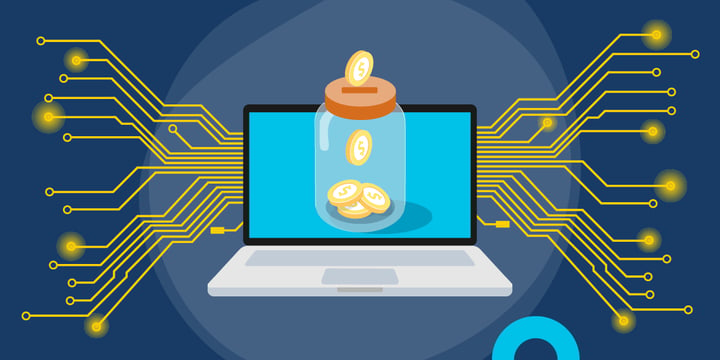How did a concept, little known to the general public just a year ago, become a major disruptor in the world of fundraising as we know it? A new form of art is gaining traction in the cryptocurrency space. Whether you believe it to be a fad or the future, millions of dollars in donations for nonprofit organizations and charities have been generated through this technology in the last few years. In October 2021, the highest donation of cryptocurrency was made for $3.5 million. So what is this trend, how might it benefit nonprofit organizations, and most importantly how can you take advantage of this opportunity?

What Is an NFT?
First, it is important to understand the basis of this form of donation. The funds fueling these large donations are being generated from the sale of an NFT, or nonfungible token. "Nonfungible" is a unique digital identifier, describing something that cannot be copied, substituted, or divided. "Token," at its core, is a generalized word for something that holds value. Within this environment, "token" is often used interchangeably with "cyptocurrency" or "cryptoasset."
An NFT, then, is a cryptoasset on a blockchain that has unique and distinguishable identification codes and metadata. A blockchain is a system in which a record of transactions made in bitcoin or another cryptocurrency are maintained across several computers that are linked in a peer-to-peer network.
The most common iteration of NFTs on the market now is digital art. These assets are bought, purchased, and stored on a public blockchain, which prevents the duplication of the asset and confirms ownership. While the use cases for this technology are endless, we will focus solely on the use of NFTs for fundraising purposes.
Other helpful words and platforms:
- Blockchain: A system of recording information in a way that makes it difficult or impossible to change, hack, or cheat the system. This technology is the base on which NFTs are built and on which the cryptocurrencies to purchase them are created.
- OpenSeas: Marketplace for NFTs — think eBay.
- MetaMask: A wallet for your cryptocurrency used to purchase and sell NFTs on OpenSeas.
- Ethereum: Commonly used cryptocurrency and the crypto of choice for buying and selling on OpenSeas.
- Minting: The process of turning a digital file into a cryptoasset on the ethereum blockchain, or creating an NFT.
- Project: A collection of NFTs that look the same either in form or style but are made up of individual pieces of art. The most famous project is the Bored Ape Yacht Club.
- Community: Group of people who own an NFT within a project, often with the ability to vote and contribute toward decisions around financials, donations, mission, and strategy.
How NFTs Generate Funds
There are two main ways in which NFTs have been producing and distributing funds for charitable causes and nonprofit organizations. The first way is through the standard selling of NFTs for a profit. This is done either by minting an NFT and selling it or by "flipping" an NFT by selling an existing asset for more than it was purchased for. The seller then takes their earnings and selects a charitable cause to donate all, or a portion, of their funds. Jack Dorsey, founder and former CEO of Twitter, turned his first tweet into an NFT and sold it for $2.9 million, all of which he donated to GiveDirectly.
The second way that NFTs are generating funds is through projects created with the intention of raising money for a specific cause. Recently, Ellen DeGeneres created and auctioned off an NFT to raise money for the World Central Kitchen. Additionally, there are NFT projects whose communities or founders include charitable giving as a cornerstone of their mission. Dainty Dolphins is an NFT project whose aim is to raise awareness of this endangered species and donates a large portion of proceeds to community-chosen charities.
A common question we see when clients are looking to enter the NFT or crypto space is how there is value in these items. We often get asked, "Can't someone just take a picture of the digital art?" Technically, yes. So why are people spending so much money on these assets?
Fundraising Using NFTs
There are two major classifications for the value that NFTs create: novelty and utility. Both can be leveraged within the nonprofit sector. Being built on the blockchain, NFTs by definition are one of a kind. This creates value through scarcity. Think rookie baseball cards or a limited-edition Rolex. Nonprofit organizations can use NFTs in this way through creating value-aligned art and raising awareness and money, much like Dainty Dolphins did.
NFTs as a novelty item can be leveraged in a similar way to organizational swag. For example, offering access to an NFT instead of a T-shirt for raising a certain amount of money for a charitable walk or race. Organizations can also develop NFT art as a standalone fundraiser. UNICEF just launched 1,000 NFTs to celebrate its 75th anniversary in the United Nations to raise money and awareness for education and children.
Looking to launch your own NFT? TechSoup Marketing Services can lead you through strategy, art and design, minting, and promotion.
Building Communities Using NFTs
While novelty NFTs are a powerful way to generate funding, the ability to create NFT utility is where the sustainable value lies. Utility, within the NFT space, is the value given based on special access, perks, or opportunities. Gary Vaynerchuk, a well-known entrepreneur and media personality, created NFTs with utility so in-demand that his NFT project VeeFriends has sold for more than $500,000. These NFTs give the owners exclusive access to perks like special gifts, tickets to his conference, and even one-on-one hangouts with Gary and mentorship opportunities.
Nonprofit organizations can link their NFTs with utility in endless ways, from exclusive access to galas and events to celebrity access, and more. For example, an organization that has a yearly gala can sell a high-priced NFT that ensures that the buyer has a ticket to the gala every year — and can even be passed down to their children! NFTs are most popular among younger generations like millennials and Gen Z. For organizations struggling with an aging community and support base, this environment is the perfect place to meet the next generation of donors where they are online.
Nonprofit organizations thrive on their ability to create, maintain, and grow a loyal and engaged community. The utility aspect of NFTs can be leveraged to attract, convert, and grow key stakeholders for your organization. NFT communities could even replicate a board structure, allowing for communal decision-making and community buy-in.
Whether you are looking to boost your fundraising or engage and grow your community, TechSoup Marketing Services is here to provide you with expert strategy and support.
Important Considerations for Entering the Crypto Space
Trading and investing in cryptocurrency carries a high level of risk. Both NFTs and the cryptocurrency required to purchase them, ethereum, are volatile assets and are not subject to Federal Deposit Insurance Corporation (FDIC) or Securities Investor Protection Corporation protections. This information should not be interpreted as financial advice.
Cryptocurrency, additionally, has a negative impact on the environment due to high energy consumption. Learn more about the impact of cryptocurrency and NFT minting.
Additional Resources
- Read about The Current State of Blockchain in Philanthropy.
- Learn How to Accept Cryptocurrency Donations at Your Nonprofit.
- See a webinar from Public Good App House: Giving Apps — Fundraising, In-Kind Gifts, and Volunteering.
- Look into TechSoup Courses' series Fundraising for Nonprofits.
Top photo: Shutterstock









